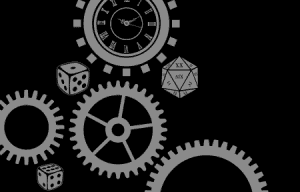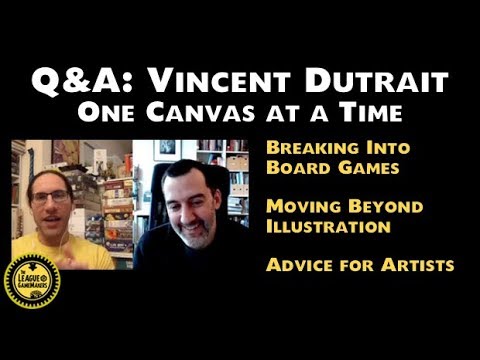
“EVERYTHING WAS GOING FINE FOR A WHILE. I THOUGHT I HAD EVERYTHING UNDER CONTROL. BUT WHEN I STARTED SENSING THAT, DESPITE MY BEST EFFORTS, THINGS JUST COULDN’T COME TOGETHER, I PANICKED. I DID WAY MORE THAN WHAT IS RECOMMENDED, AND I OD’ED. I TOTALLY OVER-DESIGNED.”

Over-designing (OD’ing) is more common than you expect, and the effects can be devastating. Most abusers simply don’t recover. A lucky few, however, are able to break the cycle of OD’ing and get clean. Gahm Dessinger, hailing from Spielstadt, Germany, is one success story. I had the privilege to be able to sit down with him that he might offer some words of inspiration and hope to other designers who have OD’ed.
Mike (M): Mr. Dessinger, thank you for taking time out of your day to share your wisdom with us.
Gahm (G): Thank you, Michael. The League of Gamemakers has been an inspiration to me, and I am humbled to be able to contribute.
M: Well, first of all, how are you feeling?
G: I’m feeling wonderful. I haven’t OD’ed for seven years now.
M: That’s fantastic! Congratulations.
G: Thank you.
M: Let’s go back, if I may, to the first time you OD’ed. How did you know that you over-designed?
G: How did I know? Honestly, I didn’t know. I thought the design was wonderful and unique. It wasn’t until I had some outsiders playtest the game that I first began to get a clue.
M: What clues, exactly?
G: I got feedback saying such things like, “It’s too complicated given the theme,” “It takes too long,” “There are too many moving parts,” and “If I were designing this, I would take such and such out.”
M: How did that make you feel?
G: I thought they were idiots! “If I were designing this…” Well then go design something!
M: But weren’t they right?
G: Oh certainly. I know that now. But then, all I knew is that I had a reason for every detail, every mechanic. If something were taken away, it would reveal a hole that I had already discovered and “fixed.” They were suggesting that I tear apart my own baby!
M: So it was then that you realized you OD’ed?
G: Sadly, no, not even then. Actually, I continued to OD.
M: Really? How so?
G: Well, for example, they said that the mechanics were too complicated given the theme, so I re-themed the game. I changed my target audience from casual gamers to hardcore gamers. Then, to justify the set-up and play time, and to increase replay-ability within my new audience, I added five variants of play. I thought the game was bigger and better than ever, and I was flying high.
M: Describe the moment when you realized that you had OD’ed.
G: I don’t suppose it was any one particular moment. Many small red flags. Publishers seemed interested in the concept, but didn’t want to pick it up. When it was a casual game, it included an “aide” for players to reference. When I changed it to a hardcore game, that aide became a page long in small font! Despite that, my players kept being confused about a few of the same issues. I continued to tweak the design for three years, but it was beyond saving.
M: So you were never able to fix it?
G: No. I had poured too much of myself into it. If I were to take anything away, it would feel like ripping out a part of myself. I knew why everything was there and how it all connected. But I was the only one.
IF I WERE TO TAKE ANYTHING AWAY, IT WOULD FEEL LIKE RIPPING OUT A PART OF MYSELF.
M: Wow, that’s devastating. I know this must be difficult to retell, and I appreciate you sharing. Now we need to talk about how other designers can fix an over-designed game, if possible, and how to hopefully avoid it in the first place. What advice can you give?
G: In counseling, I learned—
M: You were in counseling for this?
G: Yes. In counseling, I learned one quote that I repeat to myself every time I design. It is from Antoine de Saint Exupéry. He says
“PERFECTION IS ACHIEVED, NOT WHEN THERE IS NOTHING MORE TO ADD, BUT WHEN THERE IS NOTHING LEFT TO TAKE AWAY.”
M: Very poignant.
G: Yes. Are you going to put that in big orange text on your blog?
M: Of course.
G: Very good. My counselor told me that anyone can make a design more complex. That is easy. The skill is manifest in simplicity. Can that be in big orange text, too?
M: I don’t want to OD it…
G: Hah! Very good.
M: But how can a designer reduce the complexity of a design?
G: First of all, let me say that not every complex game is a victim of over-designing. Some are still very tight, and very good games. But if you relate to some of the things that I experienced with my design, there are some ways to reverse the damage. Your League has an article about choosing your design landmark? That is very important. Think back to what you first liked about your game, what makes it fun. Defend that hill.
Next, scrutinize your instructions. Consider every time you use the word “if” and “except.” You might have conditional rules for different situations, like, “If this happens, then do this, unless this is the case, then do this.” Do those really have to be conditional? Often those rules are difficult to explain to people in the first place, and difficult for them to remember and understand.
M: Wow, that a lot of things to think about. Even a little overwhelming. Where do you start?
G: Since I keep a playtest journal, I know all the changes I made to the game and when. Think of your design like an onion. Consider every change to your design as a layer. The outermost layers are probably the least necessary, and taste like paper. Achtung! Danger! Peel those away completely.

THINK OF YOUR DESIGN LIKE AN ONION.
M: You said earlier that if you were to do that, it would have revealed holes.
G: Yes, and I thought that adding layers on top of it fixed it. But the way to fix a broken mechanic is not to add more mechanics. Focus on the important mechanic. Spend the time tightening and fixing it. Ask for help from friends. Pose questions on forums. You are less likely to OD if you have a network of support around you.
M: Do you think it would be easier if you weren’t emotionally attached to your design?
G: Perhaps, yes. But I do not think that is the answer. That emotional attachment is what drives the design to completion. It is what gives you the endurance to discover eight ways to fail before finding a mechanics that works. Without that passion, you will end up with a game that lacks connection with the audience, if you end up with a game at all.
M: Inspiring words, Mr. Dessinger. Again, on behalf of the League and its readers, thank you for spending time with me today. Best of luck to you on your designs.
G: Thank you, Michael.








